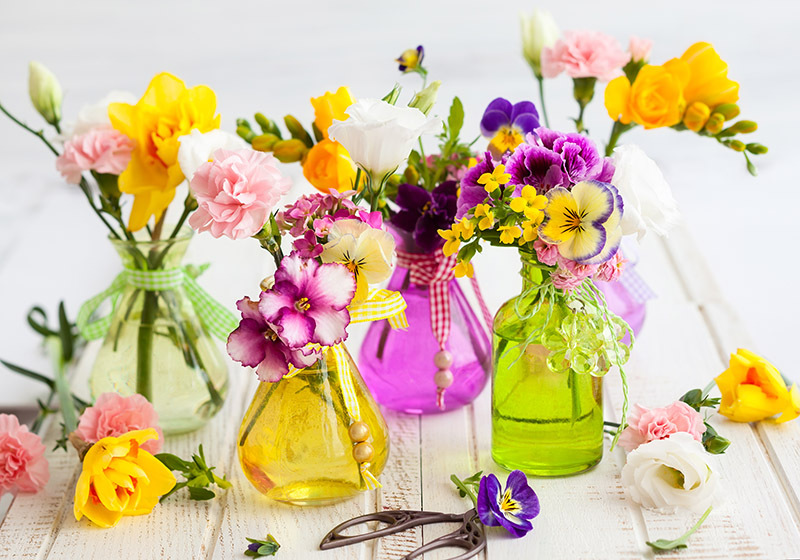Step-by-step guidance to maintaining lush hydrangeas
Posted on 21/08/2025
Step-by-Step Guidance to Maintaining Lush Hydrangeas
Hydrangeas are celebrated for their eye-catching blooms and elegant foliage, making them a favorite in gardens worldwide. To ensure your hydrangeas thrive and remain vibrant season after season, proper maintenance is essential. This comprehensive guide provides step-by-step instructions on how to keep your hydrangeas lush, healthy, and full of striking flowers.
Understanding Hydrangeas: Types & Growth Habits
Before diving into hydrangea care, it's important to recognize the different varieties of hydrangeas. They fall into several categories, each with its own growth pattern and care requirements:
- Bigleaf Hydrangea (Hydrangea macrophylla): Known for their bright blue, pink, or purple flowers.
- Peegee or Panicle Hydrangea (Hydrangea paniculata): Boasting conical clusters of white flowers that may mature to pink.
- Oakleaf Hydrangea (Hydrangea quercifolia): Recognized by their oak-like foliage and cone-shaped white blooms.
- Smooth Hydrangea (Hydrangea arborescens): Noted for ball-shaped white to greenish flowers.
- Climbing Hydrangea (Hydrangea petiolaris): Grows as a vine, featuring lacy white blooms.
Understanding your hydrangea's type will help you tailor the maintenance approach to achieve the best results.

Step 1: Choosing the Right Location for Lush Hydrangeas
A successful, robust hydrangea begins with smart placement. When selecting a location in your garden consider these critical factors for optimal hydrangea growth:
- Light: Most hydrangeas thrive in morning sun with afternoon shade. Panicle varieties tolerate more sunlight, while bigleaf and oakleaf types require shade during the hottest hours.
- Soil: Opt for well-drained, rich, and loamy soil. Hydrangeas dislike standing water, which can cause root rot.
- Protection: Shelter your hydrangeas from harsh winds, which can dry out blooms and damage branches.
Step 2: Proper Planting Techniques
Planting your hydrangea correctly sets the stage for lush development. Follow this simple yet effective hydrangea planting process:
- Dig a wide hole, about 2-3 times the width of the root ball. This will encourage the roots to spread horizontally.
- Position the plant so that the crown is level with or just above the soil surface.
- Backfill with enriched soil, mixing in compost to provide an early nutrient boost.
- Water thoroughly immediately after planting, ensuring moisture reaches the roots.
Pro Tip:
Amend heavy clay or sandy soil with organic matter to improve texture and fertility for your hydrangeas.
Step 3: Watering Hydrangeas for Maximum Lushness
Consistent and deep watering is vital to maintain lush, thriving hydrangea blooms. Here are essential watering guidelines:
- Frequency: Water at least 1 inch per week, increasing during hot or dry periods.
- Timing: Water early in the morning to minimize evaporation and fungal risks.
- Method: Hydrangeas benefit most from slow, deep watering at the soil level to encourage strong root development.
- Mulching: Apply a 2-3 inch layer of mulch to maintain even soil moisture and keep roots cool.
Avoid watering overhead, as wet foliage can increase the risk of disease.
Step 4: Feeding and Fertilizing Hydrangeas
Feeding your hydrangeas ensures they remain vigorous and lush year after year. Pay attention to the following feeding essentials:
- Timing: Apply a balanced, slow-release fertilizer in early spring when buds start to form.
- Product: Use a formulation designed for flowering shrubs. Avoid high-nitrogen fertilizers that promote leafy growth at the expense of blooms.
- Techniques: Scatter fertilizer around the drip line, and lightly work it into the soil, followed by thorough watering.
Over-fertilization can harm root systems and decrease flower production, so follow package instructions closely.
Step 5: Pruning Hydrangeas for Maximum Blooms
Pruning hydrangeas increases airflow, shapes the plant, and encourages lush, productive flowering. The correct timing and method depend on the hydrangea variety:
Bigleaf and Oakleaf Hydrangeas
- These bloom on old wood. Prune immediately after flowering, cutting back to a healthy set of buds.
- Remove weak or dead stems during late winter or early spring.
Panicle and Smooth Hydrangeas
- They flower on new wood. Prune in late winter or early spring before growth begins, cutting stems to 1/3 of their length for compact, lush growth.
Climbing Hydrangeas
- Prune sparingly after blooms fade, mainly to control size and shape.
Use sharp, clean tools and always trim at a 45-degree angle above new buds to encourage robust regrowth.
Step 6: Managing Soil pH for Vibrant Flower Color
Did you know you can influence the color of bigleaf hydrangeas by modifying your soil's pH? Here's how to achieve those coveted hues:
- Blue Blooms: Provide acidic soil with a pH below 6.0. Amend soil with aluminum sulfate or organic matter like pine needles.
- Pink Blooms: Aim for alkaline soil with a pH above 6.5. Add lime to raise the pH.
- Purple Blooms: Maintain a pH between 6.0 and 6.5.
Test your soil annually to monitor pH and make gradual adjustments, as drastic changes can stress the plant and decrease lushness.
Step 7: Pest and Disease Control for Healthy Hydrangeas
Although hydrangeas are relatively resilient, some pests and diseases can affect their lushness. Stay vigilant for these common issues:
Common Hydrangea Pests
- Aphids - Rinse with a sharp spray of water or treat with insecticidal soap.
- Spider Mites - Increase humidity around plants, and treat severe infestations with horticultural oil.
- Slugs and Snails - Use slug bait or set up barriers to protect tender foliage.
Typical Diseases
- Powdery Mildew - Avoid overcrowding and wet leaves. Apply a fungicide if needed.
- Leaf Spot - Remove infected foliage promptly; keep leaves dry with proper watering.
For all issues, early detection and prompt action are key to maintaining healthy, lush hydrangeas.
Step 8: Overwintering Hydrangeas for Year-Round Lushness
In colder climates, proper winter care is crucial to protect hydrangeas and ensure a lush display in the following season. Take these precautions:
- Mulch: Apply a thick layer of mulch or straw around the base in late fall to insulate roots.
- Wrap: For sensitive types, wrap shrubs in burlap to shield from bitter winds and frost.
- Water: Continue to water during dry spells until the ground freezes.
Bonus Tips for Achieving the Lushest Hydrangeas
- Divide plants every few years to maintain vigor and prevent overcrowding.
- Monitor for chlorosis (yellowing leaves), which can indicate nutrient deficiencies.
- Incorporate companion plants like ferns and hostas, which share similar moisture and shade preferences.
- Regularly deadhead spent blooms to promote continuous flowering, though some varieties are attractive even after fading.
Did You Know?
The word "hydrangea" comes from Greek, meaning "water vessel"--a nod to their love of moisture and lush growth habits!

Frequently Asked Questions on Caring for Lush Hydrangeas
How do I keep my hydrangeas blooming all summer?
Provide consistent moisture and partial sunlight, fertilize in early spring, and deadhead regularly. Choose reblooming varieties for an extended display.
Why are my hydrangea leaves turning brown or wilting?
This typically points to under-watering, intense sun, or wind stress. Ensure your soil stays moist, provide afternoon shade, and shield from strong winds.
Can I move my hydrangea without hurting it?
Yes! Transplant in early spring or fall, dig a wide root ball, and replant quickly. Water generously and avoid fertilizing for a few weeks afterward.
What is the best fertilizer for hydrangeas?
A balanced fertilizer like 10-10-10 works for most varieties. Use a low-phosphorus formula to encourage blue flowers in bigleaf types if desired.
How can I make my hydrangea flowers bigger?
Deadhead regularly, prune correctly according to their type, maintain rich soil, and ensure deep watering during bud formation.
Conclusion: Achieve Lush Hydrangeas in Every Garden
Lush hydrangeas don't have to be a mystery. With the right placement, soil, care, and attention to seasonal needs, your hydrangeas will reward you with vibrant greenery and fabulous blooms every year. By following this step-by-step guidance for hydrangea maintenance, gardeners of all skill levels can create thriving displays that elevate any landscape. Keep observing your plants, adapt care as needed, and enjoy the abundance of your hydrangea garden for seasons to come!
```Latest Posts
Crafting a Lasting Display with Your Poinsettias
8 Unexpected Facts About Sunflowers You Need to Know
Tulip Tidbits: Seven Facts That Will Surprise You






